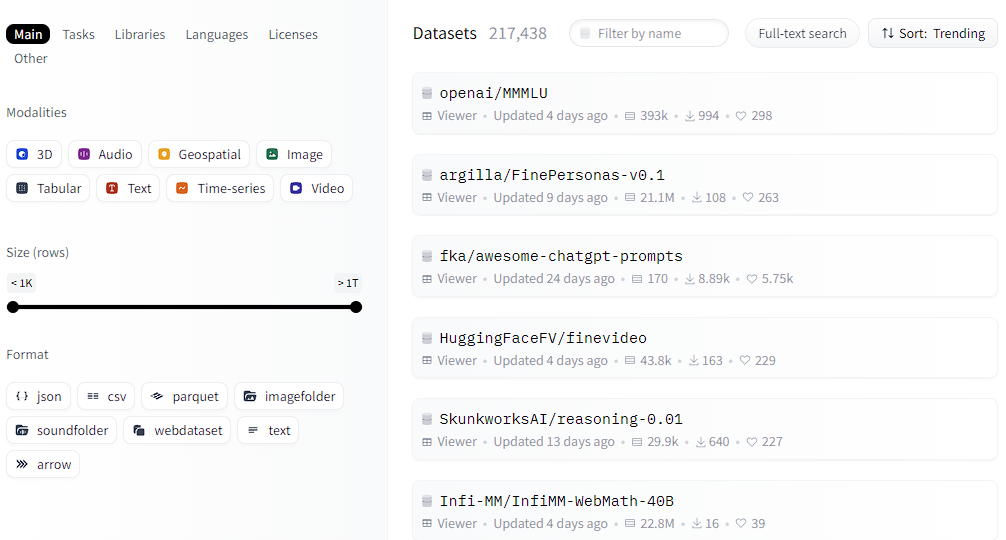Hugging Face has emerged as a pivotal platform in the AI ecosystem, offering invaluable resources for developers, researchers, and startups venturing into the world of artificial intelligence. Founded in 2016, this New York-based company has rapidly evolved into a hub for machine learning innovation, providing a comprehensive suite of tools and services that democratize AI development. The last time I felt like this was when a friend of mine showed me alt binaries newsgroups.
A Collaborative AI Ecosystem
At its core, Hugging Face is a platform where the machine learning community collaborates on models, datasets, and applications. This collaborative environment fosters innovation and knowledge sharing, making it an ideal starting point for those learning about AI. It has old school internet community vibes to it, which for some may make it seem unprofessional, but that is not what this is about, and I think the name is their way of letting everyone know, “we are here for the lulz not the suites.”
Open-Source Foundation
One of Hugging Face’s most significant contributions is its open-source library, Transformers. This Python package contains implementations of popular transformer models for text, image, and audio tasks. For developers new to AI, this means access to state-of-the-art models without the need to build them from scratch, significantly lowering the barrier to entry.
Hugging Face democratizes AI like GitHub democratized code. One million models and counting—the future of machine learning is open source.
Extensive Model Hub
The platform hosts over one million public models, with a new repository being created approximately every ten seconds. This vast collection covers a wide range of applications, from chatbots to specialized models in biology and chemistry. For startups and individual developers, this means quick access to pre-trained models that can be fine-tuned for specific use cases, saving time and computational resources.
Hugging Face offers several features that make it particularly helpful for those learning about AI. The Datasets Library provides easy access to a wide range of datasets, crucial for training and testing AI models. Spaces allows developers to create and share web applications showcasing their machine learning projects, fostering a learn-by-doing approach. The platform’s community engagement encourages discussions and collaboration, enabling developers to learn from peers and experts in the field.
 With over 200k datasets and the ability to filter on modalities, rows, and format, Hugging Face has it all
With over 200k datasets and the ability to filter on modalities, rows, and format, Hugging Face has it all
Startup Acceleration
For startups, Hugging Face offers more than just technical resources. Their enterprise solutions provide enterprise-grade security and dedicated support, allowing startups to scale their AI initiatives safely, which at the time of writing this is $20 per user per month.
In collaboration with Meta and Scaleway, Hugging Face is part of an accelerator program that supports European startups in integrating open foundation models into their products. I don’t know much about this program but hope it will extend to the US sometime soon.
Unlike many AI startups, Hugging Face has achieved profitability, setting an example for sustainable growth in the AI sector.
Bridging Academia and Industry
Hugging Face’s platform serves as a bridge between academic research and practical applications. By hosting models from both researchers and industry practitioners, it allows for rapid dissemination of new AI techniques and their real-world implementations.
When academic research meets practical application, innovation accelerates. Hugging Face is where AI papers become products.
Future-Oriented Approach
As AI continues to evolve, Hugging Face is positioning itself at the forefront of innovation. The platform is expanding beyond text-based AI to include image, video, audio, and even 3D applications. Collaborations with organizations like IBM and NASA demonstrate Hugging Face’s commitment to leveraging AI for societal benefits, such as improved weather forecasting.
When it comes to getting your hands dirty in the world of AI, I do not think there is a better place to go than Hugging Face. If you have not checked them out, you should. The tutorials that they have are one of the reasons why I stopped writing them. I will have an article coming soon about how to get setup in Hugging Face, because I honestly think that is the best way for engineers to explore AI.
The platform represents more than just a repository of models—it’s a community, a learning environment, and a launchpad for AI innovation. In a world where AI is becoming increasingly important, Hugging Face ensures that these powerful tools remain accessible to everyone, not just those with massive computational budgets or PhD-level expertise.
Whether you’re a curious developer taking your first steps into AI or a startup looking to integrate machine learning into your product, Hugging Face offers a welcoming environment where you can learn, experiment, and build the future of artificial intelligence.
Vatché
Tinker, Thinker, AI Builder. Writing helps me formulate my thoughts and opinions on various topics. This blog's focus is AI and emerging tech, but may stray from time to time into philosophy and ethics.

 With over 200k datasets and the ability to filter on modalities, rows, and format, Hugging Face has it all
With over 200k datasets and the ability to filter on modalities, rows, and format, Hugging Face has it all